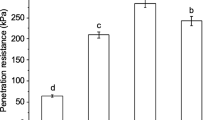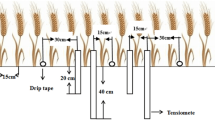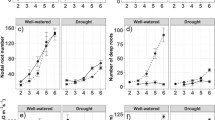Abstract
Two upland rice varieties, Azucena and Bala, were screened for root growth under droughted and irrigated treatments in two field sites at the West Africa Rice Development Association (WARDA) experimental farm, Côte d’Ivoire, during the dry season of 1999/2000. The sites were chosen to represent contrasting soil profile penetration resistance (PR) characteristics on upland sites, although both were relatively impeding. The number of nodal root axes per unit area passing through horizontal transects (root density) was counted at 35, 56, 77 and 98 days after sowing (DAS) at 10 cm depth intervals. Azucena consistently maintained a greater root density than Bala and a greater proportion of Azucena roots grew to 30 cm depth (22.7% vs. 8.4% at 77 DAS). There was little detectable effect of water regime on root distribution but evidence of lower root numbers at depths below 20 cm in the higher PR site was revealed. A site by variety by soil depth interaction suggests that Azucena roots are more strongly affected by very high PR than those of Bala. PR between 0–30 cm depth increased greatly with decreasing soil water content during the drought as the soil dried. This increase is likely to have prevented or greatly impaired further nodal root growth within this layer. At 40 cm depth, PR was high (3–4 MPa) but did not increase during the drought. At this depth root growth rate was likely to be greatly reduced despite the availability of water. These results demonstrate that varietal differences in root morphology characterised in the laboratory can be also detected in impeding field soils as differences in the density of roots at depth. Relatively poor root growth in these fields in the absence of drought was probably due to the high mechanical impedance and/or the physiological stress of the plants in the dry season. Our results indicate that high mechanical impedance was a more fundamental constraint on root growth than soil water availability during the drought. Thus, varietal differences in root penetration ability might be very important for drought avoidance in soils of this type.
Similar content being viewed by others
Abbreviations
- PR:
-
penetration resistance
- DAS:
-
days after sowing
References
Ali M L, Pathan M S, Zhang J, Bai G, Sarkarung S and Nguyen H T 2000 Mapping QTL for root traits in a recombinant inbred population from two indica ecotypes in rice. Theor. Appl. Genet. 101, 756–766.
Bengough A G 1997 Modelling rooting depth and soil strength in a drying soil profile. J. Theor. Biol. 186, 327–338.
Bengough A G, Campbell D J and O’Sullivan M F 2001 Penetrometer techniques in relation to soil compaction and root growth. In Soil and Environmental Analysis. Eds. K A Smith and C E Mullins. pp. 377–404. Marcel Dekker, New York, USA.
Bengough A G and Mullins C E 1990 Mechanical impedance to root growth: A review of experimental techniques and root growth responses. J. Soi. Sci. 41, 341–358.
Bingham I J 2001 Soil-root-canopy interactions. Ann. App. Biol. 138, 243–251.
Boonjung H and Fukai S 1996 Effects of soil water deficit on growth stages on rice growth and yield under upland conditions. 1. Growth during drought. Field Crop. Res. 48, 37–45.
Cairns J E 2003 Analysis of environmental effects on expression of root penetration QTLs in upland rice. Ph.D. thesis. University of Aberdeen, UK.
Champoux M C, Wang G, Sarkarung S, Mackill D J, O’Toole J C, Huang N and McCouch S R 1995 Locating genes associated with root morphology and drought avoidance in rice via linkage to molecular markers. Theor. Appl. Genet. 90, 969–981.
Chaudhary D and Rao M J B K 1982 Breeding rice varieties for dryland and drought-prone areas of India. In Drought resistance in crops with the emphasis of rice. pp. 265–272. IRRI, Manila, Philippines.
Clark L J, Aphale S L and Barraclough P B 2000 Screening the ability of rice roots to overcome mechanical impedance of wax layers; importance of test conditions and measurement criteria. Plant Soil 219, 187–196.
Clark L J, Cope R E, Whalley W R, Barraclough P B and Wade L J 2002 Root penetration of strong soil in rainfed lowland rice: comparison of laboratory screens with field performance. Field Crop. Res. 76, 189–198.
Ekanayake I J, O’Toole J C, Garrity D P and Masajo T M 1985 Inheritance of root growth characters and their relations to drought resistance in rice. Crop. Sci. 25, 927–933.
Fukai S and Cooper M 1995 Development of drought-resistant cultivars using physio-morphological traits in rice. Field Crop. Res. 40, 67–86.
Hasegawa S, Thangaraj M and O’Toole J C 1985 Root behavior: field and laboratory studies for rice and nonrice crops. In Soil Physics and Rice. pp. 383–395. International Rice Research Institute, Manila, Philippines.
Hekkeling R T A, Smaling E M A and Diatta S 1989 Detailed Soil Survey and Land Evaluation of the WARDA Experimental Area, Bouaké, Côte d’Ivoire. Report 22. Winand Staring Centre, Wageningen.
Ingram K T, Bueno F D, Namuco O S, Yambao E B and Beyrouty C A 1994 Rice root traits for drought resistance and their genetic variation. In Rice roots: Nutrient and water use. Ed. G J D Kirk. pp. 67–77. International Rice Research Institute, Manila, Philippines.
Ley G J, Mullins C E and Lal R 1995 The potential restriction to root growth in structurally weak tropical soils. Soil Till. Res. 33, 133–142.
Lilley J M and Fukai S 1994a Effect of timing and severity of water deficit on four diverse rice cultivars. I. Rooting pattern and soil water extraction. Field Crop. Res. 37, 205–213.
Lilley J M and Fukai S 1994b Effect of timing and severity of water deficit on four diverse rice cultivars. II. Physiological responses to soil water deficit. Field Crop. Res. 37, 215–223.
Mambani B and Lal R 1983 Response of upland rice varieties to drought stress. I. Relation between the root system development and leaf water potential. Plant Soil 73, 59–72.
Mullins C E, Blackwell P S and Tisdall J M 1992 Strength development during drying of a cultivated, flood-irrigated hardsetting soil. I. Comparison with a structurally stable soil. Soil Till. Res. 25, 113–128.
Nguyen H T, Babu R C and Blum A 1997 Breeding for drought resistance in rice: physiological and molecular genetics considerations. Crop. Sci. 37, 1426–1434.
O’Toole J C 1982 Adaptation of rice to drought prone environments. In Drought Resistance in Crops With Emphasis on Rice. pp. 195–213. International Rice Research Institute, Manila, Philippines.
O’Toole J C and Soemartono 1981 Evaluation of a simple technique for characterising rice root systems in relation to drought resistance. Euphytica 30, 283–290.
Passioura J B 1982 The Role Of Root System Characteristics in Drought Resistance of Crop Plants. In Drought Resistance in Crops With Emphasis on Rice. pp. 71–82. International Rice Research Institute, Manila, Philippines.
Price A H, Cairns J E, Horton P, Jones, H G and Griffiths H 2002b Linking drought-resistance mechanisms to drought avoidance in upland rice using the QTL approach: Progress and new opportunities to integrate stomatal and mesophyll responses.
Price A H and Courtois B 1999 Mapping QTLs associated with drought resistance in rice: progress, problems and prospects. Plant Growth Reg. 29, 123–133.
Price A H, Steele K A, Gorham J, Bridges J M, Moore B J, Evans J, Richardson P and Wyn-Jones G 2002 Upland rice grown in soil-filled chamfers exposed to contrasting water-deficit regimes. I. Root distribution, water use and plant water status. Field Crop. Res. 76, 11–24.
Price A H, Steele K A, Moore B J, Barraclough P B and Clark L J 2000 A combined RFLP and AFLP linkage map of upland rice (Oryza sativa L.) used to identify QTLs for root-penetration ability. Theor. App. Genet. 100, 49–56.
Price A H and Tomas A D 1997 Genetic dissection of root growth in rice (Oryza sativa L.). II. Mapping quantitative trait loci using molecular markers Theor. App. Genet. 95, 143–152.
Price A H, Virk D S and Tomas A D 1997 Genetic dissection of root growth in rice (Oryza sativa L.). I. A hydroponic screen. Theor. App. Genet. 95, 132–142.
Samson B K, Hasan M and Wade L J 2002 Penetration of hardpans of rice lines in the rainfed lowlands. Field Crop. Res. 76, 175–188.
Thangaraj M, O’Toole J C and De Datta S K 1990 Root response to soil water stress in rainfed lowland rice. Expl. Agric. 26, 287–296.
Wairiu M, Mullins C E and Campbell D 1993 Soil physical factors affecting the growth of sycamore (Acer pseudoplatanus L.) in a silvopastoral system on a stony upland soil in North-East Scotland. Agrofor. System 24, 295–306
Yadav R, Courtois B, Huang N and McLaren G 1997 Mapping genes controlling root morphology and root distribution in a double-haploid population of rice. Theor. App. Genet. 94, 619–632.
Yoshida S and Hasegawa S 1982 The rice root system: Its development and function. In Drought Resistance in Crops with Emphasis on Rice. pp. 97–114. International Rice Research Institute, Manila, Philippines.
Yu L, Ray J D, O’Toole J C and Nguyen H T 1995 Use of wax-petroleum layers for screening rice root penetration. Crop. Sci. 35, 684–687.
Zhang J, Babu R C, Pantuwan G, Kamoshita A, Blum A, Sarkarung S, O’Toole J C and Nguyen H T 1999 Molecular dissection of drought tolerance in rice: from physio-morphological traits to field performance. In Genetic Improvement of Rice for Water-Limited Environments. Eds. O Ito, J C O’Toole and B Hardy. pp. 331–343. International Rice Research Institute, Manila, Philippines.
Zhang W P, Shen X Y, Wu P, Hu B and Laio C Y 2001 QTLs and epistasis for seminal root length under different water supply in rice (Oryza sativa L.). Theor. App. Genet. 103, 118–123.
Author information
Authors and Affiliations
Corresponding author
Rights and permissions
About this article
Cite this article
Cairns, J.E., Audebert, A., Townend, J. et al. Effect of soil mechanical impedance on root growth of two rice varieties under field drought stress. Plant Soil 267, 309–318 (2004). https://doi.org/10.1007/s11104-005-0134-1
Received:
Accepted:
Issue Date:
DOI: https://doi.org/10.1007/s11104-005-0134-1




